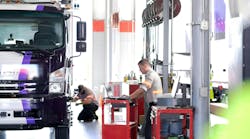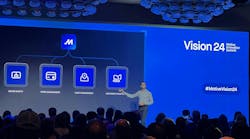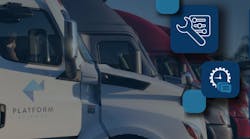One of the most misunderstood, and misused, terms in trucking is “black box.” To some it's synonymous with electronic onboard recorders (EOBR), to others it means a Big-Brother device just waiting for them to make a mistake, and to the more technical-minded it's simply any device that records information about an unusual vehicle-related event. Depending on who you talk to, the black box is a tracking device, an automated drivers' log system, a tattletale, a training tool, or every liability lawyer's dream.
The problem is an onboard recording system can be any or all of those things. For example, the earliest onboard recorders introduced to the industry more than 20 years ago only captured and stored basic operating data such as time spent over speed or RPM limits. Their application was limited to fleets intensely interested in controlling driver behavior. Only after wireless communications and standardized data busses became widely available did many fleets see a value in onboard systems since they could now attack productivity issues with detailed vehicle operating data and location information obtained in near real-time.
Then there's the Federal Motor Carrier Safety Administration (FMCSA), which at present is solely interested in EOBRs as a way to automate logs, despite the fact that most systems on the market that can do logs also provide tracking and vehicle-performance monitoring.
Muddying the waters even further, there is a push today among federal regulators to mandate vehicle data recorders like those used in commercial aircraft for passenger cars. Drawing on vehicle data from a wide array of electronic controls and sensors, such devices would presumably give investigators objective data about the contributing causes to any accident.
Such an accident-related device is, in the strictest sense, the only one that deserves the name “black box.” However, in order to fulfill that mission, the black box will also have the capability of performing those other functions that deliver value to a fleet operator — tracking, performance monitoring, communications and overall collection of vehicle-related information including driver hours and diagnostic data. In other words, a cost-effective black box — one fleets will be willing to pay for — will be far more than a black box.
For most fleet executives, the value of such multi-functional onboard systems is well understood because they have a direct impact on productivity. What many may be overlooking, however, is the additional value offered by the black box capabilities. Or what developers, in an effort to sidestep the negative connotations of the term black box, prefer to call “event data recorder” functions.
THE NEW GENERATION
If you haven't looked at driver monitoring systems in a while, you'll probably be surprised at just how much they've changed in recent years. “Twenty years ago you had to connect [an onboard monitor] with hard wires to the engine, the speedometer and so on to collect that information,” says Tom Flies, vp business development at Xata Corp.
With the development of a standardized data bus, “you could just plug into it and you had speed, distance traveled, rpm, fuel consumption, brake actuations and a lot more information,” he says. “Then those systems merged with wireless communications and GPS. Now if there's an accident or event, you can determine exact position for the vehicle, direction of travel, brake application and throttle position at the time of the incident.”
Fleets that choose to use these tools to change driver behavior also reduce costs and, in the long run, improve the overall efficiency of their operations, says Flies. For example, event recorders will quickly identify drivers who operate at high speeds for long periods or those that habitually tailgate and have to hit the brakes hard too often. Coaching those drivers to use cruise control to keep their speed down and to avoid hard braking by increasing following distances not only makes them safer drivers, but also makes them more fuel efficient drivers, Flies points out.
“An efficient driver is a safe driver,” says Brian McLaughlin, vp-marketing for mobile management system provider PeopleNet. “We have a few applications grouped under driver performance and safety management, and we've found that the two go hand in hand.”
When PeopleNet introduced its newest generation of onboard event recorder, the primary function was accident recreation. “If the unit senses sudden deceleration, it automatically sends [location, speed, braking and other vehicle] data right to the fleet's offices,” says McLaughlin. “The idea is that the fleet can quickly respond to an accident situation, contacting authorities and taking whatever immediate action is needed.”
However, fleets have proven more interested in using the recorder for driver training than accident reconstruction. “In this day of driver shortages, it's not about firing drivers, but about helping them through safety bonuses or constructive types of consultation,” says McLaughlin.
In response, PeopleNet has added features that focus on identifying driver behaviors rather than just recording data in the event of an accident. For example, the system can now draw on a database of local roads to constantly compare a truck's actual speed to a particular road's speed limit. “Knowing a driver is doing 65 mph is one thing, but knowing he's doing it in a 35 mph zone is more important,” says McLaughlin.
“The evolution of rich data sources like that speed-limit database and the ability to have real-time communications has made [event data recorders] much more valuable to fleets because it provides precise, exception-based data that they can act on.”
MORE OPPORTUNITIES
Because they're smarter, collect more precise data and communicate it more quickly, today's event data recorders offer inventive fleets “so many opportunities for savings,” says Kelly Frey, vp sales and service for Turnpike Global Technologies, a provider of EOBRs and web-based fleet management applications. “Telematics data can do much more than tell you what happened before an accident.”
With location information, for example, a fleet can tell that one driver's hard braking usually occurs on highway ramps and provide that driver with personalized training about entering and exiting high-speed roadways.
One of Turnpike's larger customers — a TL carrier with operations throughout North America — offers another innovative example of black-box use. “Their driver managers spend a lot of time with new hires making sure that they're safe drivers and that they comply with company policies on the road,” says Frey. “With EOBRs collecting and clearly identifying information on speeding, hard braking, idling time and off-route miles, they get a much more detailed analysis of how each new driver is performing and need fewer driver managers to oversee that function.”
Just collecting performance data with an event recorder or EOBR isn't enough these days, adds Brendan Staub, Turnpike's president. “Supervisory negligence is a new term that's becoming more common [in liability cases],” he says. “You not only have to have the data, but you also have to prove you've been proactive in effecting change based on that data to avoid that charge.”
Staub offers a five-step process for using such data most effectively:
-
Establish a baseline with a new EOBR system over a few months so you know your average speeds, hard braking numbers, and so on
-
Use that data to identify areas that need work
-
Establish desired threshold for each area and devise a plan for reaching them
-
Monitor performance and address any issues needed to achieve your objectives
-
And, finally, establish new objectives as you achieve old ones to foster continuous improvement.
“Too many fleets rush to respond with ad hoc solutions to individual problems” identified by event recorders, says Staub. “The biggest return on investment [in EOBRs] comes from using that data to monitor systematic changes that you've put in place.”
A STEP BEYOND
While the current generation of EOBRs offers a good deal of information on driver behaviors, there are other systems on the market that provide even greater detail for those fleets that want it.
When Eaton introduced its VORAD collision warning and side-object detection system in 1994, it felt it needed a tool to demonstrate the effectiveness of the system to potential fleet customers, so it created an electronic data collector to capture system activity on the road and software to interpret that data.
The EVT 200 data recorder “was really an engineering tool,” recalls David Pierson, sales manager for Eaton's new Vehicle Solutions Business Unit (VSBU). “We put it in a truck with VORAD and let drivers drive for 30 days without any display or warning signals. Then we let the system provide drivers with warnings for another 30 days. With [the data recorder] we could demonstrate how the driver's behavior changed for the better when they received warnings about following too closely or being inattentive.”
Fleets liked what they saw, but they told Eaton they would only buy the VORAD system if it also included the data recorder and software, according to Pierson. Those fleets recognized that the data increased VORAD's functionality and value, changing it from a just a driver warning device to a system that could be used for accident reconstruction and managing driver training.
Today as Eaton prepares to introduce the third-generation data recorder, 90% of fleets using VORAD do so for accident recreation and about 50% for driver management. Information from its radar sensors in front and alongside of the truck, as well of a yaw sensor that indicates steering inputs, provides a much more accurate picture of driver and vehicle activities.
For example, it doesn't just identify hard braking instances, but actually records how closely a driver follows another vehicle and for how long. In reconstructing an accident, the radar can provide telemetry information on up to 20 vehicles in front of the truck for 10 minutes preceding the event, as well as identify stationary objects or passing cars alongside the truck. Brake applications, throttle position and driver steering inputs all add even more detail to the reconstruction.
“Fleets use the accident reconstruction differently,” says Pierson. “Some use it with every incident, even a scratch in a parking lot. Others, only for serious accidents. It's helped a lot of fleets vindicate their drivers by showing they weren't at fault. And many believe that if they are at fault, it's best to know that as soon as possible.”
Eaton has also announced a new partnership with @Road that will combine VORAD information with vehicle data from @Road's EOBR and provide wireless communications over the company's network.
“Users can schedule data dumps and generate histograms for all or any single driver over a 12-week period,” says Pierson. “They can ping a truck and get real-time information. Or they can set up rules for real-time notification of exceptions so they can contact a driver immediately.”
While VORAD certainly has value as a warning system for the driver, “in many cases fleets don't want the system without the data recording features,” says Pierson. “They want to be able to proactively manage their drivers and modify their behavior to avoid accidents.”
SEEING IS BELIEVING
Reports based on data collected by a black box can certainly help fleets modify unsafe driver habits, but a visual record of their behavior on the road makes a much more powerful impression. With an event data recorder, “drivers that exceed fleet thresholds are brought in by a supervisor and shown a graph,” says Del Lisk, vp safety services for DriveCam Video Systems. “With our system, you let the driver watch a 20-sec. clip, and then figure out together how to avoid that problem in the future. In terms of establishing credibility with drivers and getting them to understand underlying unsafe behaviors, video goes much farther than data.”
As the name implies, DriveCam uses a digital video recorder mounted on a truck's windshield. One camera records everything occurring in front of the truck, another activity inside the cab. The video stream is captured continuously, but only saved in a 20-sec. clip if the vehicle experiences a high-force event like a sudden swerve or deceleration. Drivers can also hit a button to manually save the previous 20 seconds of video.
Captured video is downloaded by computer to DriveCam, which has staff experts review the clips, analyze each event and build a risk profile fore each driver, Lisk explains. “That lets fleets identify who are their riskiest and safest drivers,” he says. “We also identify cases of high concern so the fleet can have a coaching session with that driver. With an event data recorder, you can use data to tell when drivers braked, and how hard, but you can't tell why they did what they did when they did it.
“Letting the driver see what happened is a more positive way to help them uncover unconscious bad habits,” says Lisk. “We don't want [the system] to be seen as a threat, but rather as a coaching tool.”
In the final analysis, providing your drivers with the tools that make them safe and successful can only improve your operations. Whether you simply choose to use the event data recorder features of your current EOBR or decide to supplement them with more sophisticated technologies like radar and video, it may be time to look inside that black box for safer, more efficient drivers.


